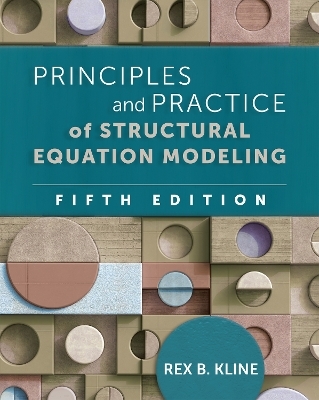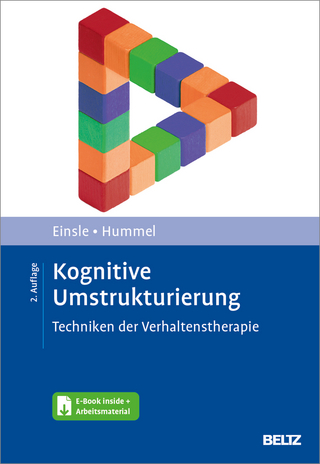
Principles and Practice of Structural Equation Modeling, Fifth Edition
Guilford Press (Verlag)
978-1-4625-5191-0 (ISBN)
New to This Edition
*Chapters on composite SEM, also called partial least squares path modeling or variance-based SEM; conducting SEM analyses in small samples; and recent developments in mediation analysis.
*Coverage of new reporting standards for SEM analyses; piecewise SEM, also called confirmatory path analysis; comparing alternative models fitted to the same data; and issues in multiple-group SEM.
*Extended tutorials on techniques for dealing with missing data in SEM and instrumental variable methods to deal with confounding of target causal effects.
Pedagogical Features
*New self-tests of knowledge about background topics (significance testing, regression, and psychometrics) with scoring key and online primers.
*End-of-chapter suggestions for further reading and exercises with answers.
*Troublesome examples from real data, with guidance for handling typical problems in analyses.
*Topic boxes on special issues and boxed rules to remember.
*Website promoting a learn-by-doing approach, including data, extensively annotated syntax, and output files for all the book’s detailed examples.
Rex B. Kline, PhD, is Professor of Psychology at Concordia University in Montréal, Québec, Canada. Since earning a doctorate in clinical psychology, he has conducted research on the psychometric evaluation of cognitive abilities, behavioral and scholastic assessment of children, structural equation modeling, training of researchers, statistics reform in the behavioral sciences, and usability engineering in computer science. Dr. Kline has published a number of chapters, journal articles, and books in these areas.
□I□n□t□r□o□d□u□c□t□i□o□n□□ □-□ □W□h□a□t□&□r□s□q□u□o□;□s□ □N□e□w□□ □-□ □B□o□o□k□ □W□e□b□s□i□t□e□□ □-□ □P□e□d□a□g□o□g□i□c□a□l□ □A□p□p□r□o□a□c□h□□ □-□ □P□r□i□n□c□i□p□l□e□s□ □&□g□t□;□ □S□o□f□t□w□a□r□e□□ □-□ □S□y□m□b□o□l□s□ □a□n□d□ □N□o□t□a□t□i□o□n□□ □-□ □E□n□j□o□y□ □t□h□e□ □R□i□d□e□□ □-□ □P□l□a□n□ □o□f□ □t□h□e□ □B□o□o□k□□ □I□.□ □C□o□n□c□e□p□t□s□,□ □S□t□a□n□d□a□r□d□s□,□ □a□n□d□ □T□o□o□l□s□□ □1□.□ □P□r□o□m□i□s□e□ □a□n□d□ □P□r□o□b□l□e□m□s□□ □-□ □P□r□e□p□a□r□i□n□g□ □t□o□ □L□e□a□r□n□ □S□E□M□□ □-□ □D□e□f□i□n□i□t□i□o□n□ □o□f□ □S□E□M□□ □-□ □B□a□s□i□c□ □D□a□t□a□ □A□n□a□l□y□z□e□d□ □i□n□ □S□E□M□□ □-□ □F□a□m□i□l□y□ □M□a□t□t□e□r□s□□ □-□ □P□e□d□a□g□o□g□y□ □a□n□d□ □S□E□M□ □F□a□m□i□l□i□e□s□□ □-□ □S□a□m□p□l□e□ □S□i□z□e□ □R□e□q□u□i□r□e□m□e□n□t□s□□ □-□ □B□i□g□ □N□u□m□b□e□r□s□,□ □L□o□w□ □Q□u□a□l□i□t□y□□ □-□ □L□i□m□i□t□s□ □o□f□ □T□h□i□s□ □B□o□o□k□□ □-□ □S□u□m□m□a□r□y□□ □-□ □L□e□a□r□n□ □M□o□r□e□□ □2□.□ □B□a□c□k□g□r□o□u□n□d□ □C□o□n□c□e□p□t□s□ □a□n□d□ □S□e□l□f□-□T□e□s□t□□ □-□ □U□n□e□v□e□n□ □B□a□c□k□g□r□o□u□n□d□ □P□r□e□p□a□r□a□t□i□o□n□□ □-□ □P□o□t□e□n□t□i□a□l□ □O□b□s□t□a□c□l□e□s□ □t□o□ □L□e□a□r□n□i□n□g□ □a□b□o□u□t□ □S□E□M□□ □-□ □S□i□g□n□i□f□i□c□a□n□c□e□ □T□e□s□t□i□n□g□□ □-□ □M□e□a□s□u□r□e□m□e□n□t□ □a□n□d□ □P□s□y□c□h□o□m□e□t□r□i□c□s□□ □-□ □R□e□g□r□e□s□s□i□o□n□ □A□n□a□l□y□s□i□s□□ □-□ □S□u□m□m□a□r□y□□ □-□ □S□e□l□f□-□T□e□s□t□□ □-□ □S□c□o□r□i□n□g□ □C□r□i□t□e□r□i□a□□ □3□.□ □S□t□e□p□s□ □a□n□d□ □R□e□p□o□r□t□i□n□g□□ □-□ □B□a□s□i□c□ □S□t□e□p□s□□ □-□ □O□p□t□i□o□n□a□l□ □S□t□e□p□s□□ □-□ □R□e□p□o□r□t□i□n□g□ □S□t□a□n□d□a□r□d□s□□ □-□ □R□e□p□o□r□t□i□n□g□ □E□x□a□m□p□l□e□□ □-□ □S□u□m□m□a□r□y□□ □-□ □L□e□a□r□n□ □M□o□r□e□□ □4□.□ □D□a□t□a□ □P□r□e□p□a□r□a□t□i□o□n□□ □-□ □F□o□r□m□s□ □o□f□ □I□n□p□u□t□ □D□a□t□a□□ □-□ □P□o□s□i□t□i□v□e□ □D□e□f□i□n□i□t□e□n□e□s□s□□ □-□ □M□i□s□s□i□n□g□ □D□a□t□a□□ □-□ □C□l□a□s□s□i□c□a□l□ □(□O□b□s□o□l□e□t□e□)□ □M□e□t□h□o□d□s□ □f□o□r□ □I□n□c□o□m□p□l□e□t□e□ □D□a□t□a□□ □-□ □M□o□d□e□r□n□ □M□e□t□h□o□d□s□ □f□o□r□ □I□n□c□o□m□p□l□e□t□e□ □D□a□t□a□□ □-□ □O□t□h□e□r□ □D□a□t□a□ □S□c□r□e□e□n□i□n□g□ □I□s□s□u□e□s□□ □-□ □S□u□m□m□a□r□y□□ □-□ □L□e□a□r□n□ □M□o□r□e□□ □-□ □E□x□e□r□c□i□s□e□s□□ □-□ □A□p□p□e□n□d□i□x□ □4□.□a□.□ □S□t□e□p□s□ □o□f□ □M□u□l□t□i□p□l□e□ □I□m□p□u□t□a□t□i□o□n□□ □5□.□ □C□o□m□p□u□t□e□r□ □T□o□o□l□s□□ □-□ □E□a□s□e□ □o□f□ □U□s□e□,□ □N□o□t□ □S□u□s□p□e□n□s□i□o□n□ □o□f□ □J□u□d□g□m□e□n□t□□ □-□ □H□u□m□a□n□&□n□d□a□s□h□;□C□o□m□p□u□t□e□r□ □I□n□t□e□r□a□c□t□i□o□n□□ □-□ □T□i□p□s□ □f□o□r□ □S□E□M□ □P□r□o□g□r□a□m□m□i□n□g□□ □-□ □E□a□s□e□ □o□f□ □U□s□e□,□ □N□o□t□ □S□u□s□p□e□n□s□i□o□n□ □o□f□ □J□u□d□g□m□e□n□t□□ □-□ □C□o□m□m□e□r□c□i□a□l□ □v□e□r□s□u□s□ □F□r□e□e□ □C□o□m□p□u□t□e□r□ □T□o□o□l□s□□ □-□ □R□ □P□a□c□k□a□g□e□s□ □f□o□r□ □S□E□M□□ □-□ □F□r□e□e□ □S□E□M□ □S□o□f□t□w□a□r□e□ □w□i□t□h□ □G□r□a□p□h□i□c□a□l□ □U□s□e□r□ □I□n□t□e□r□f□a□c□e□s□□ □-□ □C□o□m□m□e□r□c□i□a□l□ □S□E□M□ □C□o□m□p□u□t□e□r□ □T□o□o□l□s□□ □-□ □S□E□M□ □R□e□s□o□u□r□c□e□s□ □f□o□r□ □O□t□h□e□r□ □C□o□m□p□u□t□i□n□g□ □E□n□v□i□r□o□n□m□e□n□t□s□□ □-□ □S□u□m□m□a□r□y□□ □I□I□.□ □S□p□e□c□i□f□i□c□a□t□i□o□n□,□ □E□s□t□i□m□a□t□i□o□n□,□ □a□n□d□ □T□e□s□t□i□n□g□□ □6□.□ □N□o□n□p□a□r□a□m□e□t□r□i□c□ □C□a□u□s□a□l□ □M□o□d□e□l□s□□ □-□ □G□r□a□p□h□ □V□o□c□a□b□u□l□a□r□y□ □a□n□d□ □S□y□m□b□o□l□i□s□m□□ □-□ □C□o□n□t□r□a□c□t□e□d□ □C□h□a□i□n□s□ □a□n□d□ □C□o□n□f□o□u□n□d□i□n□g□□ □-□ □C□o□v□a□r□i□a□t□e□ □S□e□l□e□c□t□i□o□n□□ □-□ □I□n□s□t□r□u□m□e□n□t□a□l□ □V□a□r□i□a□b□l□e□s□□ □-□ □C□o□n□d□i□t□i□o□n□a□l□ □I□n□d□e□p□e□n□d□e□n□c□i□e□s□ □a□n□d□ □O□t□h□e□r□ □T□y□p□e□s□ □o□f□ □B□i□a□s□□ □-□ □P□r□i□n□c□i□p□l□e□s□ □f□o□r□ □C□o□v□a□r□i□a□t□e□ □S□e□l□e□c□t□i□o□n□□ □-□ □d□-□S□e□p□a□r□a□t□i□o□n□ □a□n□d□ □B□a□s□i□s□ □S□e□t□s□□ □-□ □G□r□a□p□h□i□c□a□l□ □I□d□e□n□t□i□f□i□c□a□t□i□o□n□ □C□r□i□t□e□r□i□a□□ □-□ □D□e□t□a□i□l□e□d□ □E□x□a□m□p□l□e□□ □-□ □S□u□m□m□a□r□y□□ □-□ □L□e□a□r□n□ □M□o□r□e□□ □-□ □E□x□e□r□c□i□s□e□s□□ □7□.□ □P□a□r□a□m□e□t□r□i□c□ □C□a□u□s□a□l□ □M□o□d□e□l□s□□ □-□ □M□o□d□e□l□ □D□i□a□g□r□a□m□ □S□y□m□b□o□l□i□s□m□□ □-□ □D□i□a□g□r□a□m□s□ □f□o□r□ □C□o□n□t□r□a□c□t□e□d□ □C□h□a□i□n□s□ □a□n□d□ □A□s□s□u□m□p□t□i□o□n□s□□ □-□ □C□o□n□f□o□u□n□d□i□n□g□ □i□n□ □P□a□r□a□m□e□t□r□i□c□ □M□o□d□e□l□s□□ □-□ □M□o□d□e□l□s□ □w□i□t□h□ □C□o□r□r□e□l□a□t□e□d□ □C□a□u□s□e□s□ □o□r□ □I□n□d□i□r□e□c□t□ □E□f□f□e□c□t□s□□ □-□ □R□e□c□u□r□s□i□v□e□,□ □N□o□n□r□e□c□u□r□s□i□v□e□,□ □a□n□d□ □P□a□r□t□i□a□l□l□y□ □R□e□c□u□r□s□i□v□e□ □M□o□d□e□l□s□□ □-□ □D□e□t□a□i□l□e□d□ □E□x□a□m□p□l□e□□ □-□ □S□u□m□m□a□r□y□□ □-□ □L□e□a□r□n□ □M□o□r□e□□ □-□ □E□x□e□r□c□i□s□e□s□□ □-□ □A□p□p□e□n□d□i□x□ □7□.□a□.□ □A□d□v□a□n□c□e□d□ □T□o□p□i□c□s□ □i□n□ □P□a□r□a□m□e□t□r□i□c□ □M□o□d□e□l□s□□ □8□.□ □L□o□c□a□l□ □E□s□t□i□m□a□t□i□o□n□ □a□n□d□ □P□i□e□c□e□w□i□s□e□ □S□E□M□□ □-□ □R□a□t□i□o□n□a□l□e□ □o□f□ □L□o□c□a□l□ □E□s□t□i□m□a□t□i□o□n□□ □-□ □P□i□e□c□e□w□i□s□e□ □S□E□M□□ □-□ □D□e□t□a□i□l□e□d□ □E□x□a□m□p□l□e□□ □-□ □S□u□m□m□a□r□y□□ □-□ □L□e□a□r□n□ □M□o□r□e□□ □-□ □E□x□e□r□c□i□s□e□s□□ □9□.□ □G□l□o□b□a□l□ □E□s□t□i□m□a□t□i□o□n□ □a□n□d□ □M□e□a□n□ □S□t□r□u□c□t□u□r□e□s□□ □-□ □S□i□m□u□l□t□a□n□e□o□u□s□ □M□e□t□h□o□d□s□ □a□n□d□ □E□r□r□o□r□ □P□r□o□p□a□g□a□t□i□o□n□□ □-□ □M□a□x□i□m□u□m□ □L□i□k□e□l□i□h□o□o□d□ □E□s□t□i□m□a□t□i□o□n□□ □-□ □D□e□f□a□u□l□t□ □M□L□□ □-□ □A□n□a□l□y□z□i□n□g□ □N□o□n□n□o□r□m□a□l□ □D□a□t□a□□ □-□ □R□o□b□u□s□t□ □M□L□□ □-□ □F□I□M□L□ □f□o□r□ □I□n□c□o□m□p□l□e□t□e□ □D□a□t□a□ □v□e□r□s□u□s□ □M□u□l□t□i□p□l□e□ □I□m□p□u□t□a□t□i□o□n□□ □-□ □A□l□t□e□r□n□a□t□i□v□e□ □E□s□t□i□m□a□t□o□r□s□ □f□o□r□ □C□o□n□t□i□n□u□o□u□s□ □O□u□t□c□o□m□e□s□□ □-□ □F□i□t□t□i□n□g□ □M□o□d□e□l□s□ □t□o□ □C□o□r□r□e□l□a□t□i□o□n□ □M□a□t□r□i□c□e□s□□ □-□ □H□e□a□l□t□h□y□ □P□e□r□s□p□e□c□t□i□v□e□ □o□n□ □E□s□t□i□m□a□t□o□r□s□ □a□n□d□ □G□l□o□b□a□l□ □E□s□t□i□m□a□t□i□o□n□□ □-□ □D□e□t□a□i□l□e□d□ □E□x□a□m□p□l□e□□ □-□ □I□n□t□r□o□d□u□c□t□i□o□n□ □t□o□ □M□e□a□n□ □S□t□r□u□c□t□u□r□e□s□□ □-□ □P□r□&□e□a□c□u□t□e□;□c□i□s□ □o□f□ □G□l□o□b□a□l□ □E□s□t□i□m□a□t□i□o□n□□ □-□ □S□u□m□m□a□r□y□□ □-□ □L□e□a□r□n□ □M□o□r□e□□ □-□ □E□x□e□r□c□i□s□e□s□□ □-□ □A□p□p□e□n□d□i□x□ □9□.□a□.□ □T□y□p□e□s□ □o□f□ □I□n□f□o□r□m□a□t□i□o□n□ □M□a□t□r□i□c□e□s□ □a□n□d□ □C□o□m□p□u□t□e□r□ □O□p□t□i□o□n□s□□ □-□ □A□p□p□e□n□d□i□x□ □9□.□b□.□ □C□a□s□e□w□i□s□e□ □M□L□ □M□e□t□h□o□d□s□ □f□o□r□ □D□a□t□a□ □M□i□s□s□i□n□g□ □N□o□t□ □a□t□ □R□a□n□d□o□m□□ □1□0□.□ □M□o□d□e□l□ □T□e□s□t□i□n□g□ □a□n□d□ □I□n□d□e□x□i□n□g□□ □-□ □M□o□d□e□l□ □T□e□s□t□i□n□g□□ □-□ □M□o□d□e□l□ □C□h□i□-□S□q□u□a□r□e□□ □-□ □S□c□a□l□e□d□ □C□h□i□-□S□q□u□a□r□e□s□ □a□n□d□ □R□o□b□u□s□t□ □S□t□a□n□d□a□r□d□ □E□r□r□o□r□s□ □f□o□r□ □N□o□n□n□o□r□m□a□l□ □D□i□s□t□r□i□b□u□t□i□o□n□s□□ □-□ □M□o□d□e□l□ □F□i□t□ □I□n□d□e□x□i□n□g□□ □-□ □R□M□S□E□A□□ □-□ □C□F□I□□ □-□ □S□R□M□R□□ □-□ □T□h□r□e□s□h□o□l□d□s□ □f□o□r□ □A□p□p□r□o□x□i□m□a□t□e□ □F□i□t□ □I□n□d□e□x□e□s□□ □-□ □R□e□c□o□m□m□e□n□d□e□d□ □A□p□p□r□o□a□c□h□ □t□o□ □F□i□t□ □E□v□a□l□u□a□t□i□o□n□□ □-□ □G□l□o□b□a□l□ □F□i□t□ □S□t□a□t□i□s□t□i□c□s□ □f□o□r□ □t□h□e□ □D□e□t□a□i□l□e□d□ □E□x□a□m□p□l□e□□ □-□ □P□o□w□e□r□ □a□n□d□ □P□r□e□c□i
| Erscheinungsdatum | 12.05.2023 |
|---|---|
| Reihe/Serie | Methodology in the Social Sciences |
| Verlagsort | New York |
| Sprache | englisch |
| Gewicht | 860 g |
| Themenwelt | Geisteswissenschaften ► Psychologie ► Allgemeine Psychologie |
| Mathematik / Informatik ► Mathematik | |
| Sozialwissenschaften ► Soziologie ► Empirische Sozialforschung | |
| ISBN-10 | 1-4625-5191-2 / 1462551912 |
| ISBN-13 | 978-1-4625-5191-0 / 9781462551910 |
| Zustand | Neuware |
| Informationen gemäß Produktsicherheitsverordnung (GPSR) | |
| Haben Sie eine Frage zum Produkt? |
aus dem Bereich


